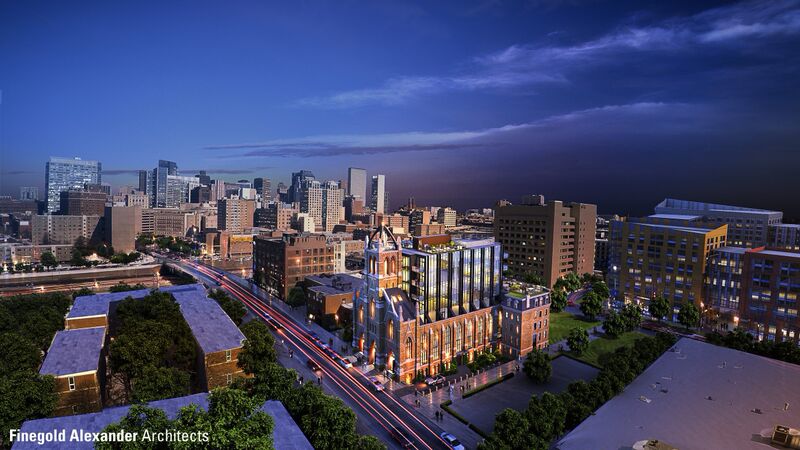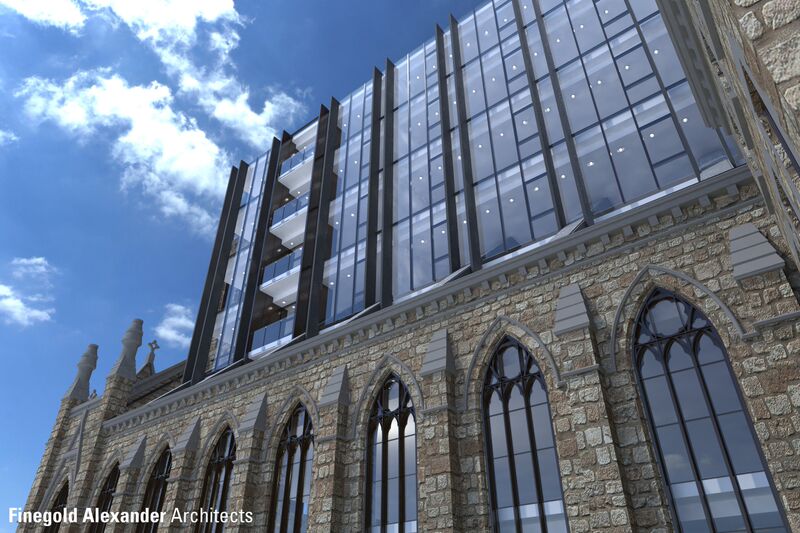
Boston boasts an eclectic array of historic structures and modern architecture. Though Boston’s current building boom leaves plenty to be desired for some who deem it mediocre and even ugly, it affords developers and designers a new way of thinking especially when it comes to transforming vacant mainstays of yore into something more desirable for today’s market. Perhaps nowhere is this more evident than 136 Shawmut.
The Holy Trinity German Church and Rectory, located at 136 Shawmut Avenue in the South End, was exactly in that kind of spot. The church, built in 1877, had been vacant for five years before New Boston Ventures (NBV) got its hands on it and teamed up with Finegold Alexander Architects (FAA) to design and build it.
Soon, having been recently approval by the Boston Redevelopment to gut the interior and build an alloy-supported framework that rises above the lion’s share of the 57,904-square foot building, the $47 million brainchild of FAA and NBV will be brought into fruition.
“We do transformative work,” said Tony Hsiao, the principal designer, about the kind of projects FAA takes on. “Everyone was struck by the fact that here’s a beautiful building with a great history. We said, what can we do with this.”
The design of 136 Shawmut is undoubtedly original and, to some, seamlessly mesh the walls of Roxbury Puddingstone – a conglomerate of sedimentary and igneous rock native to the region – with modern glass and steel.

To others, it may not strike as aesthetically pleasing.
If nothing else, the designs are sparking plenty of chatter among professionals, neighbors and, really, just about anyone who’s seen them.
“I go around to a lot of meetings with clients and they say, you’re doing that?” said Hsiao. “People are highly vocal. But I have to say the reactions I’ve been getting are positive.”
It must help, too, that NBV has strong ties to the South End neighborhood. It currently lists 44 development projects on its site of which 21 are located in the South End.
Nevertheless FAA has handled these kind of public-use-building to condo transformations before, best exemplified by the Clarendon Street Baptist Church, built in 1868, after a fire in 1982 left just three walls standing; the Penny Savings Bank, built in 1911, which prior to development sat vacant for 10-years; and the historic Peter Street Jail in Salem, built in 1813, which won the firm a trophy shelf worth of awards for preservation and historic rehabilitation.
One of FAA’s most advantageous weapon’s in this regard is ability to balance on the thin wire between preservation and restoration. It’s a dual feat that must be delicately executed for risk of damaging architectural relics and alienating a community for overdeveloping a beloved structural treasure.

Hsiao did say, however, that this particular project ranks among the top of most peculiar works FAA has undertaken.
“It brings the activity back to this building,” said Ellen Anselone, the project manager. “Bringing activity is the best thing you can do.”
Inside the church prospective residents will have their choice of 33 one- two- and three-bedroom condo units but they won’t be laid out with identical dimensions.
One of the more intriguing aspects of this particular project for FAA was recognizing that not only are they designing it, but the church itself is informative in how it will be revamped. This proved beneficial in that it helped quickly rule out what FAA could and couldn’t do.
“One of the things about this building is that it doesn’t lend itself to a cookie cutter approach to the layout,” said Anselone. “Within the envelope of the existing church, there are slightly smaller units. As you go up, the units become bigger. The upper levels have two units per floor.”
Shared amenities inside include a gym, club room that can be used for meetings, parties or movie screenings, and 28 parking spaces.
While the building and units are poised for a beautiful conversion, the most impactful facet of 136 Shawmut is that it anchors a trend of developmental preservation and restoration while also visibly mirroring the mayoral administration’s goal for showcasing the city’s innovative prowess outside of the archetypal sectors for Boston like tech, biotech and startups.
“I think this project, for us and the community, is quite an interesting,” said Hsiao. “The fact that the administration is moving toward a 21st century city in so many ways, this city should reflect that. It’s positive and forward-thinking. We should be an innovative because we are innovative city.”

